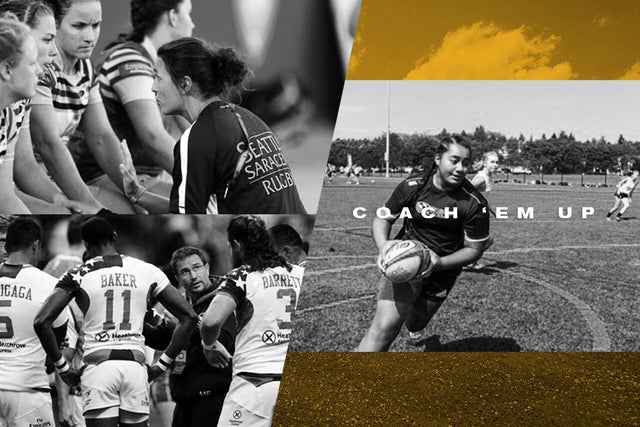Coach ‘em Up: USA Rugby Installs new structure to develop domestic coaches
Written By: Adam McQueen
For those who have grown to love the game of rugby in North America, a number of us have received our education about rucks, knock ons, and clearouts from someone with a lilt or twang in their accent that is hard to locate.
Canada and the United States' relative inexperience or 'youth' within the sport has made it customary to learn the game from those who's native land shoved a rugby ball in their hands the day they learned their first steps. It is invaluable to receive knowledge from areas of the world who have pioneered rugby’s growth throughout the professional era.
However, North American countries have overly relied upon international coaches to lead their respective national teams in recent years. From a senior men’s perspective, after Tom Billups left the helm in 2005, the US Men’s Eagles have had seven coaches, six of which were from overseas. Mike Tolkin is the only exception. In Canada’s case, their head coaches have all been internationals since Ric Suggit’s departure after the 2007 Rugby World Cup.
This is a problem. There must be a tangible path for domestic coaches to reach the pinnacle of their profession within North America. As the oft-used expressions goes “if you give a man a fish, he eats for a day. If you teach him how to fish, he will eat for a lifetime.”
With USA Rugby’s recent announcement, the launch of their coaching development program Project SOAR, they are remedying this issue. The program is designed to grow high-performance coaches in America that will lead both the men’s and women’s Eagles programs in future years. As the inaugural Major League Rugby season is set to kick off in less than a month, USA Rugby is now focused on developing domestic coaches that will nurture the growing pool of elite homegrown talent.
The goal of Project SOAR is to create a clear pathway toward the national team by establishing a unified framework that is consistent across all levels of coaching, increased information sharing, as well as hosting numerous workshops and presentations. The program will accept 150 candidates to comprise the four tiered development system. The first tier, the Talent sector, will consist of eighty players and coaches that have displayed potential at the high school level. Next, those who are already in domestic high-performance programs, such as regional academies, will make up the Performance tier. Above this will be the Elite sector, consisting of Age-Grade national level coaches and assistants. Lastly, current National Team Head Coaches and those with international experience will sit atop the program at the Master level, operating as mentors to the less experienced tiers.
This tiered system creates a clear ladder of progression for domestic coaches. Lines of communication between those in the program will be shared easily under a singular framework, guided by those coaching at the highest level in the country. JD Stephenson, National High Performance Development Manager at USA Rugby, and Manager of Project Soar, explains the rationale behind the setup:
“A linear progression and ‘ladder to climb’ allows for self reflection and development plans to be worked through with a mentor in the above tiered level,” Stephenson notes. “It also allows for a 2-1 coach to mentor ratio.”
By emphasizing the advancement towards the next tier, Project SOAR has injected a competitive atmosphere into the realm of coaching. Greater competition inevitably drives greater performance at every level. Emilie Bydwell, USA Rugby’s General Manager of Women’s High Performance, acknowledged this ripple effect in an interview with USA Rugby:
“This program not only develops our future National team and Age-Grade coaches, but advances home competition by increasing the knowledge exchange between National teams and domestic programs.”
Bydwell’s comments on knowledge exchange are an essential ingredient for American success. The nation is so geographically vast, with high-performance academies dotted across the country, that a collective source of information sharing puts coaches on the same page no matter the location or experience level. This expansion follows previous exploits conducted by USA rugby such as Eagle Files, a free online resource that demonstrates the core skills and tactics being taught by National Team coaches and players.
“The idea exchange and next practice discussions coupled with yearly workshops will facilitate coaches to connect with those they may not generally discuss ideas with on a regular basis,” says Stephenson. “We are hopeful that coaches will seize the opportunity to work out their areas of improvement and seek out those in Project SOAR that can help their development.”
Greater clarity and uniformity between coaches across the country translates into player performance. Athletes will transition seamlessly as they advance through the development pipeline, representing regional academies and ultimately the national team under the same guiding coaching principles. An increased wealth of knowledge amongst American coaches will produce domestic players that are more prepared than ever before for the ‘jump’ to the Eagles level.
USA Rugby is planting seeds now in order to reap the rewards years down the line. The long-term strategic plan of Project SOAR falls into a similar category as other recent USA Rugby initiatives, such as the Olympic Development Academy and Rookie Rugby. It is a sustainable model with a clear end goal – the United States now has the framework to breed coaches that can educate the ever-growing rugby community about the greatest sport in the world.


